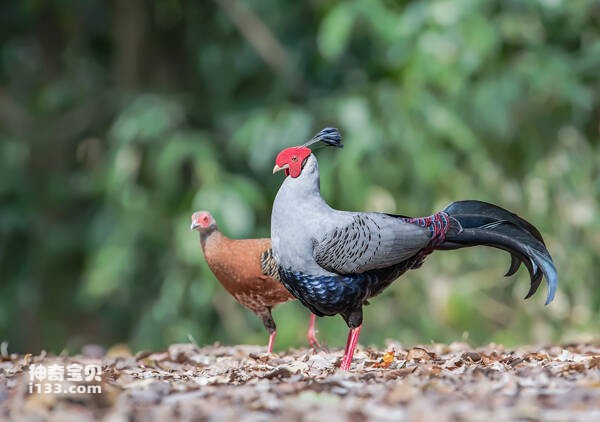Lophura diardi
IUCN
LCBasic Information
Scientific classification
- name:Lophura diardi
- Scientific Name:Lophura diardi,Siamese fireback
- Outline:Landfowl
- Family:P.genus P.family
Vital signs
- length:60-80cm
- Weight:About 1025g
- lifetime:About 20 years
Feature
The crests are clustered like peacock feathers, small at the front and larger at the end
Distribution and Habitat
It is found in Cambodia, the Lao People's Democratic Republic, Myanmar, Thailand and Vietnam.
It mainly inhabits plains and hilly areas 500 meters, but occasionally up to 800 meters, or even 1150 meters. It occurs in evergreen and semi-evergreen secondary forests, mixed woodlands, bamboo forests, and shrubs, usually near roads and railways through forests, and live in family groups.
Appearance
The pheasant's body is 60 to 80 cm long, its tail is 26 to 36 cm long, and it weighs 1,025 grams. The crest is black. The male is mainly gray in color, with most of the face without feathers, bare red, black on the throat, head, and back of the face, and mostly fine, curved gray stripes on the chest, neck, and upper back, and a long, curved, black tail. The middle and back of the back are colorful, yellow, purple and blue. The female is brown with black wings and tail feathers. It looks like a primitive chicken. Rooster face naked bright red bright, body color is not as beautiful as the ring neck pheasant, but the crest is very characteristic, the crest is a cluster of peacock feathers, the front section is small, the end is larger, but as soft as silk, very characteristic, and other pheasant crests are very different. The irises are reddish-brown and the feet are dark red.
Details
Siamese fireback (Lophura diardi) is a medium pheasant.

Thai pheasants usually live alone or in small groups of three to six individuals. In winter, there are sometimes as many as 16-17 clusters. Especially in the early morning or evening the most active, poor activity at noon, night more perches in trees. Activities often strut, act alert, run quickly after fright, crest stands, tail feathers show slightly, to run to a certain distance and then alert to observe the trend, sometimes stop and go, look around. In addition to being good at walking and running on the ground, they can also fly and jump. The wings are flapped as an aid when jumping, but sometimes they are not extended. Move your head back and forth and drop your tail slightly. There is usually no inherent territory and range of activity, and no territorial sexuality, even during reproduction.
Thai fireback alert, timid and afraid of people, when frightened from the mountain to the mountain running. Generally rarely take off, but also fly up the tree in an emergency. It usually flies from the night dwelling tree to the ground after the dawn. After eating, they usually stand in place to rest or trim feathers, and occasionally fly to a tree to rest. They live in groups in high trees at night, and generally start to roost in trees when it is dark. Generally the female first male after, or male and female together while barking, while flying up a certain height of the branches, and then gradually climb, hidden in the tall trees dense canopy, height from the ground is mostly 6-8 meters. The activity is relatively quiet and silent, and sometimes the "rustling" sound can be heard when walking. The male usually makes a "pi-you" alarm call only when there is danger.

The Pheasant is an omnivorous animal that feeds mainly on plant sprouts, fruits of various fruits and berries, roots, and seeds. They also eat animal foods such as insects, beetles, ants, snails, earthworms and small land crabs.
The pheasant's breeding season is between May and July. One female, one male. When the male bird is in heat, the crown of the forehead and the fleshy lobe of the face are swollen and red, the crown on the top of the head stands up, and he often holds his head up, the tail feathers are spread out, and the two wings are drooping. He constantly walks slowly around the female bird, while issuing 'pi.... pi ... pi... 'or' sui... sui... The sui call. Sometimes the wings are extended up and down, and other times the male stands on an outcrop or in an open part of the path and spreads his wings in a quick, narrow flap, with his tail fanning out.

The global population of the Thai fireback is estimated to be around 100,000. This species has a wide distribution range, does not approach the vulnerable endangered threshold criteria for species survival (distribution area or fluctuation range less than 20,000 square kilometers, habitat quality, population size, distribution area fragmentation), and the population trend is stable, so it is assessed as a species without survival crisis. Due to the continuous loss of habitat and excessive hunting, such as the large number of local people in Laos to kill for food, survival is not optimistic, and the wild population has declined significantly.
Listed in the International Union for Conservation of Nature Red List of Threatened Species (IUCN) for 2016 ver 3.1 - Not Threatened (LC).
Protect wild animals and eliminate wild meat.
Maintaining ecological balance is everyone's responsibility!








